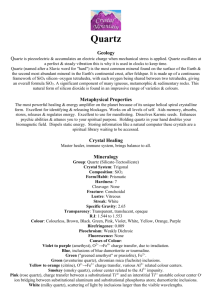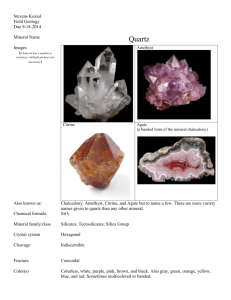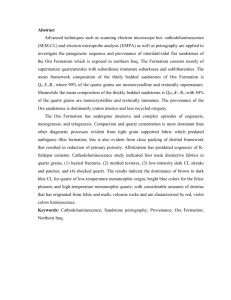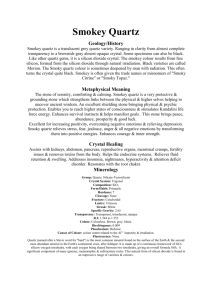LAB 4 - DETERMINATION OF REFRACTIVE INDICES OF UNIAXIAL
advertisement
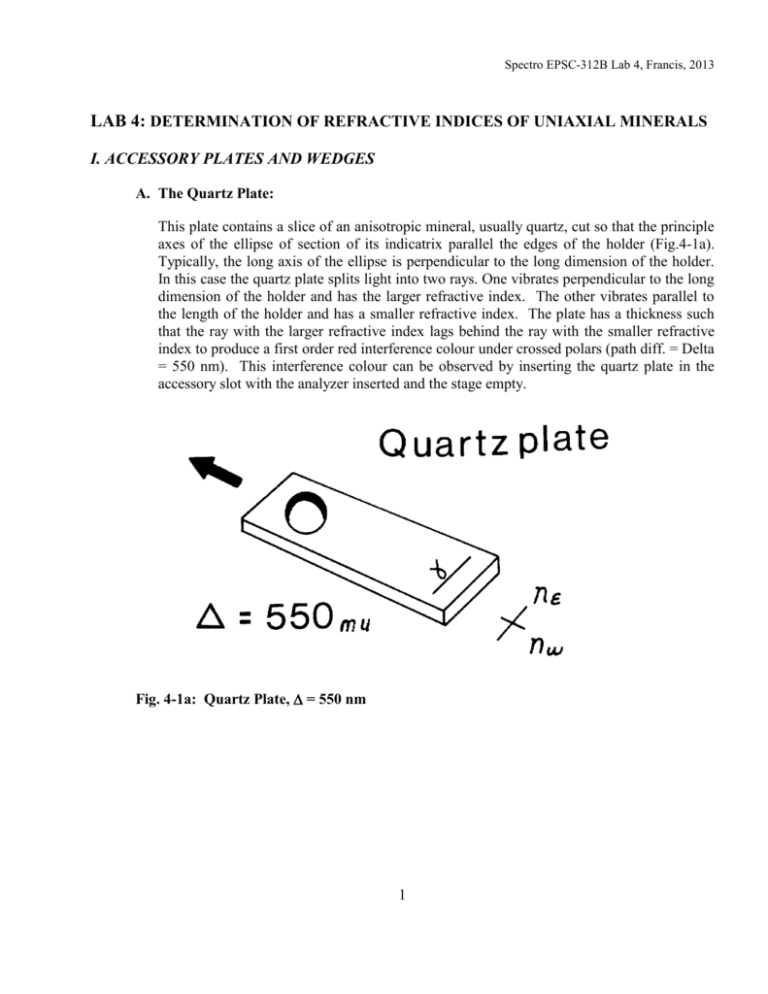
Spectro EPSC-312B Lab 4, Francis, 2013 LAB 4: DETERMINATION OF REFRACTIVE INDICES OF UNIAXIAL MINERALS I. ACCESSORY PLATES AND WEDGES A. The Quartz Plate: This plate contains a slice of an anisotropic mineral, usually quartz, cut so that the principle axes of the ellipse of section of its indicatrix parallel the edges of the holder (Fig.4-1a). Typically, the long axis of the ellipse is perpendicular to the long dimension of the holder. In this case the quartz plate splits light into two rays. One vibrates perpendicular to the long dimension of the holder and has the larger refractive index. The other vibrates parallel to the length of the holder and has a smaller refractive index. The plate has a thickness such that the ray with the larger refractive index lags behind the ray with the smaller refractive index to produce a first order red interference colour under crossed polars (path diff. = Delta = 550 nm). This interference colour can be observed by inserting the quartz plate in the accessory slot with the analyzer inserted and the stage empty. Fig. 4-1a: Quartz Plate, = 550 nm 1 Spectro EPSC-312B, Lab 4, Francis, 2010 Use of the Quartz Plate: 1) Prepare a quartz grain mount (powder #3-1). 2) Observe it under crossed polars and select a smallish grain showing the largest number of interference colour "rings" or "bands" (c axis parallel to stage). Switch to intermediate or high power and rotate the grain to extinction. 3) At this point, the principles axes of the grain's ellipse of section is parallel to the vibration directions of the microscope's polarizer and analyzer. 4) Rotate the stage 45o. Now the vibration directions of the grain are at 45o to the vibration directions of the microscope's polarizer and analyzer. 5) Insert the quartz plate. In this orientation, the vibration directions of the quartz plate parallel those of the grain under examination. Is the resultant interference colour higher or lower than that of either the quartz plate or grain alone? 6) Rotate the stage backwards 90o. Again the vibration directions of the mineral correspond to those of the plate. In this position is the interference colour higher or lower than that of the quartz plate or grain alone? 7) Quartz is a positive uniaxial mineral with Ne > Nw. In steps 5 and 6, you should have found one position corresponded to a decrease in interference colours while the other corresponded to an increase in interference colours. a) If the interference colours increased the grain's interference colours were added to that of the quartz plate and thus Nbig of the grain corresponds to Nbig of the plate. b) If the interference colours decreased, the grain's interference colours were subtracted from that of the quartz plate and thus Nbig of the grain parallels Nsmall of the quartz plate. 8) You should now be able to identify the Ne and Nw vibration directions of the quartz grain under observation. 9) Rotate the stage such that Nw of the grain is perpendicular to the vibration direction of the microscope's polarizer and Ne is parallel to it. Remove the microscope's analyzer. 10) Now the only light reaching your eye is vibrating along Ne of the grain. Determine whether Ne is greater or smaller than the refractive index of the immersion oil. 11) Repeating the above procedure with other oils and determine the value of Ne for quartz. As you approach a matching oil, check 5 or 6 suitable grains to ensure you have tested a grain with Ne exactly in the plane of the microscope stage. 2 Spectro EPSC-312B, Lab 4, Francis, 2010 B. The Quartz Wedge The quartz plate is best used for minerals of low to moderate birefringence (|Ne - Nw| not large). The reason for this is that for retardation higher than 2nd or 3rd order, it is difficult to determine the order of a given interference colour. Thus, when the quartz plate is inserted it is difficult to determine whether the interference colours rise or fall. The alternative is the Quartz wedge (Fig.4-1b). The wedge is a slice of quartz whose thickness increases along its length. Since the retardation or path difference produced by quartz = (thickness) * (Nbig - Nsmall), the retardation produced by the quartz wedge increases as it is inserted. Quartz wedges cost $500.00, treat them with care. Fig. 4-1b: Quartz Wedge, thickness. Obtain a quartz wedge from your demonstrator and place it on the stage of your microscope. Viewing with crossed polars, slowly insert the quartz wedge and observe the rising interference colours as the slice of quartz of the view increases in thickness. 1) Repeat the steps of section A to step 4 using powder #4.1. 2) Slowly insert the quartz wedge in the accessory slot. If the colour bands of the grain move towards its margins, retardation is increasing and the grain's vibration direction with the larger index parallels Nbig of the quartz wedge. Use the intermediate or high power objective when testing individual grains. 3 Spectro EPSC-312B, Lab 4, Francis, 2010 3) If the colour bands of the grain migrate towards its center, retardation is decreasing and the grain's vibration direction with the larger index of refraction parallels Nsmall of the quartz wedge. 4) Using this information you can identify which of the vibration directions of the grain has the larger refractive index. You do not know, however, whether the mineral is positive (Ne > Nw) or negative (Ne < Nw). Using the technique of Lab 3 (section D) you can identify Nε using the quadrants into which the two shadows of the uniaxial flash figure exit upon rotation of the stage from extinction. Now you can determine whether Nε corresponds to Nbig (uniaxial positive) or Nsmall (uniaxial negative) and thus determine whether the mineral is (+) or (-). 4 Spectro EPSC-312B, Lab 4, Francis, 2010 II. DETERMINATION OF THE SIGN OF A UNIAXIAL MINERAL (+ or -) 1. Minerals of low to intermediate birefringence (few or no isochrome circles in optic axis figure) a) Again prepare a quartz mount (powder #3.1). c) Find a grain which remains dark on rotation of the stage under crossed polars and obtain a uniaxial interference figure. d) Insert the quartz plate and using Fig.4-2 determine whether the optic sign of quartz is positive or negative by the position of the yellow and blue quadrants of the isogyre. Fig. 4-2: Optic sign determination using a quartz plate ( = 550 nm) for a uniaxial mineral of low birefringence. 5 Spectro EPSC-312B, Lab 4, Francis, 2010 2. Minerals of high birefringence (many isochrome circles in optic axis figure). a) Obtain an interference figure on a relatively thick sheet of phlogopite. Although this mineral is actually biaxial, its interference figure mimics that of an uniaxial mineral. b) Slowly insert a quartz wedge and observe the movement of the isochrome circles - using Fig. 4-3, determine whether the optical sign of this mineral is positive or negative. c) In the absence of a quartz wedge, a quartz plate can also be used to determine the sign of interference figures with many isochrome circles. Before insertion of the plate, locate the first order red isochrome band in the interference figure. Insert the plate and determine in which quadrants this circle changes to black (subtraction) and in which quadrants it changes to a second order red isochrome circle (addition). Fig. 4-3: Optic sign determination using a quartz wedge ( thickness) with a mineral of high birefringence 6 Spectro EPSC-312B, Lab 4, Francis, 2010 III. DETERMINATION OF Nw Now that you know how to determine the sign of a uniaxial mineral, proceeding as in section A you should be able to determine Ne and Nw of any uniaxial mineral. However, it is often faster to determine Nw using only grains with centred optic axis figures, ie. those with vertical "C" axes. Grains with this orientation will exhibit Nw for any position of the microscope stage. When the index of the oil you are using is far from Nw, any grain with "C" approximately perpendicular will do; as you approach a match, however, if the optic axis is not perfectly centred proceed as follows: 1) Rotate the stage until one of arms of isogyre coincides with the N-S cross hair. 2) In this position Nw of the mineral is E-W; if your polarizer vibrates E-W, the only light reaching your eye with the Bertrand lens out will be vibrating parallel to Nw. Using this procedure, determine Nw of powder #4.1. If your polarizer vibration direction is N-S, change the procedure accordingly. IV. UNIAXIAL UNKNOWN For mineral powder "unknown" determine: 1) optical sign 3) birefringence 2) Ne and Nw 4) any other features of note Identify the mineral using tables of refractive indices and explain the reasoning behind your identification. Once you have identified the mineral, use the refractive indices you have measured to determine the mineral’s exact composition using the appropriate graph in your book. 7


